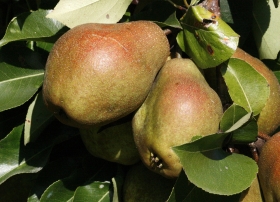No bees required.
|
Kieffer pears by GO Photo2010, on Flickr (CC license)
|
In the mid-19th century, French expat Peter Kieffer had a pear grove outside of Philadelphia where he grew two varieties of pears–the Asian sand pear (Pyrus pyrifolia) and the familiar European variety we call the Bartlett in North America (a cultivar of Pyrus communis).
(The Bartlett is called the Williams pear in Europe; around the 1760s, the variety was introduced to England as the Williams pear, named after the nursery owner who popularized it. Several of these trees were planted on an estate in Massachusetts in 1799, and the land was later sold to Enoch Bartlett, who, unaware of the origin of the trees, popularized them in the United States under his own name. In the late 1920s, more Williams trees were brought to America, and it was only then that anyone realized the mistake. But anyway, back to Kieffer.)
Bartletts are famous for their fragrant, sweet flavor and buttery texture; they’re a bit delicate when handled fresh, but retain their flavor during canning. Also, Bartletts will ripen after they’re picked–they’ll continue to get sweeter and softer. Sand pears, on the other hand, are almost more like apples–crisp and tart, with a grainy texture. They don’t taste like much of anything once they’ve been cooked, so they’re typically enjoyed fresh, and they have to be ripened on the tree.
Around 1870, Kieffer noticed a plant that didn’t look like it was either a Bartlett or sand pear tree. When it fruited in 1873, it produced a pear with the shape and aroma of a Bartlett but the color and texture of a sand pear. When he picked them, they continued to ripen, but never quite lost the crisp apple texture. He named the variety after himself (which seems to be a thing, with pears). They’re best enjoyed cooked, either in a pie or in a preserve.
Or, in this case, in a faux honey. Here’s a variation using Bartlett pears from the September 11, 1958 edition of the Wichita Falls (Texas) Times:
|
Pear honey is a syrupy jam with a wonderfully fresh flavor, a relative of that other old-fashioned sweet called pear chips. Both use pears, sugar and lemon as a base, but slivers of preserved ginger were often added to the chips. To give extra flavor and pale golden color, we add grated orange juice and rind to our pear honey.
Pear Honey
Ingredients: 4 cups chopped pears, 1/4 cup orange juice, 3 cups sugar, 1/4 teaspoon salt, 3 tablespoons lemon juice, 1 teaspoon grated orange rind., Method: Use firm-ripe Bartlett pears; pare, core, and knife-chop into 1/4 to 1/2-inch pieces; measure 4 cups, packing down. Put pears and orange juice in a medium-sized kettle; boil gently for 5 minutes. Add sugar, salt and lemon juice; boil rapidly until pears have a transparent look–about 20 minutes; the syrup will be no thicker than warm honey. Skim off foam. Stir in grated orange rind. Pour boiling hot into half-pint jars; seal at once with regular home canning caps. Makes 3 to 4 one-half pint jars. Store in a cool dry place. |
One more thing. I was a little surprised that the first recipe with honey in the title didn’t have any honey in it, if only because L.R., the owner of this box, was a member of the North Carolina Beekeeper’s Association.
From the box of L.R. from Winston-Salem, North Carolina.
Pear Honey
8 lb. peeled and cored pears (Kieffer)
1 (2 oz.) crushed pineapple
sugar
juice from 1 lemon
Peel pears and chop fine; add undrained pineapple. Add equal amounts of sugar as fruit. Add lemon and simmer until thick and clean. Pour hot into sterilzed jars and seal.
Process 10 minutes in boiling water bath.



